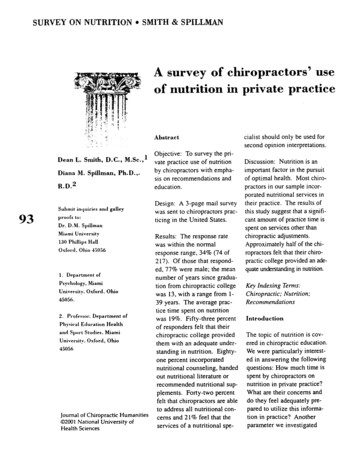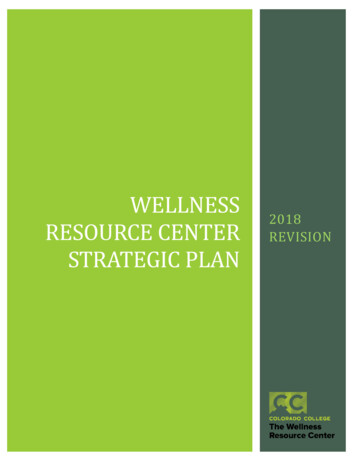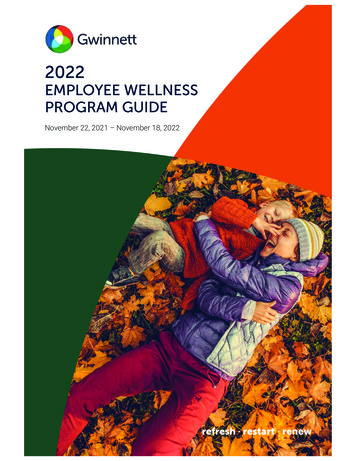
Transcription
SURVEY ON NUTRITIONSMITH & SPILLMANA survey of chiropractors' useof nutrition in private practiceAbstractDean L. Smith,R.D.*193Objective: To survey the pri-D.C., M.Sc., 1 vate practice use of nutritionDiana 31. Spillman, Ph.D.,.Submit inquiries and galleyproofs to:Dr. D.M. SpillmanMiami University130 Phillips HallOxford. Ohio 430.56cialist should only be used forsecond opinion interpretations.by chiropractors with emphasis on recommendations andeducation.Design: A 3-page mail surveywas sent to chiropractors practicing in the United States.Results: The response ratewas within the normalresponse range, 34% (74 of217). Of those that responded, 77% were male; the mean1. Department ofnumber of years since graduaPsychology, Miamition from chiropractic collegeUniversity. Oxford. Ohiowas 13, with a range from 145056.39 years. The average practice time spent on nutrition2. Professor. Department ofwas 19%. Fifty-three percentPhysical Education Healthof responders felt that theirand Sport Studies. Miamichiropractic college providedUniversity. Oxford, Ohiothem with an adequate under45056standing in nutrition. Eightyone percent incorporatednutritional counseling, handedout nutritional literature orrecommended nutritional supplements. Forty-two percentfelt that chiropractors are ableto address all nutritional conJournal of Chiropractic Humanities cernS and 2 1yo feel that the02001 National University ofservices of a nutritional speHealth SciencesDiscussion: Nutrition is animportant factor in the pursuitof optimal health. Most chiropractors in our sample incorporated nutritional services intheir practice. The results ofthis study suggest that a significant amount of practice time isspent on services other thanchiropractic adjustments.Approximately half of the chiropractors felt that their chiropractic college provided an adequate understanding in nutrition.Key Indexing Ternis:Chiropractic; Nutrition;RecommendationsIntroductionThe topic of nutrition is covered in chiropractic education.We were particularly interested in answering the followingquestions: How much time isspent by chiropractors onnutrition in private practice?What are their concerns anddo they feel adequately prepared to utilize this information in practice? Anotherparameter we investigated
SURVEY ON NUTRITIONincluded the types of supplements recommended most commonly.clinical procedures we are utilizing on a daily basis. The identity of chiropractic is intimatelyrelated to its historical separaChiropractors comprise thetion from the philosophy ofthird largest primary health care allopathy. With the use of variprofession behind medicine and ous procedures such as vitamindentistry. More than 50,000supplementation and dispensingchiropractors practice in theof herbs, are we compromisingour uniqueness in philosophy?United States. The number ofchiropractors is projected togrow rapidly to 95,200 by theMethodsyear 2005, nearly double current estimates ( I ) . Chiropractic This survey was reviewed by ais an important component ofpanel of chiropractors in privatethe American health care syspractice, one chiropractictem and the largest non-alloresearcher, a nutritionist and anpathic health profession.exercise physiologist. ThisDuring 1997, Eisenberg et al.investigation was approved by(2) estimated there were 629the iMiami University Humanmillion visits to alternativeSubjects Guideline Committee.A 3-page survey was mailed to amedicine practitioners, whichexceeded the projected number random sample of 217of visits to all primary careAmerican Doctors ofphysicians in the United States Chiropractic after a trial fieldtest.by 243 million. To call chiropractic “alternative” is problematic; in many ways it is dis- Information was requested oneducation and practice charactinctly mainstream (3).teristics, utilization of nutritionalThere has been only one inves- recommendations and counseling with an emphasis on thetigation on the use of nutritionin the private practice of chiro- types of nutrients recommended,as well as the perceived role ofpractors (4).Previous researchindicates that the national chichiropractors to offer these services to their patients.ropractic average for incorporating nutritional counseling isRespondents were assured of83.5% (5). Continued growthconfidentiality and anonymity.of the chiropractic profession is Only one mailing was sent, withinevitable and therefore, it isno following phone calls or postimportant to investigate whichcards.SMITH & SPILLMANResultsThe survey response rate was34%.This is about the normalrate of response observed insuch studies (4,6). Data from74 Doctors of Chiropractic wereincluded in the analysis. Thevast majority of chiropractors inthis survey use nutrition withtheir patients.The median year of graduationwas 1986 and the mean year ofgraduation was 1985 (Table 1).Over seventy-percent ofrespondents maintained a soloprivate practice.The average chiropractor in thissurvey operated 5 1% of theirpractice as pain or symptomrelief care. The number of,Me I. Demographic chuufcnsticsolrhe rerpondcniwM ICn-hLifeNorthwestemPalmerTCXUNation81Lxn AngelaLife Wenw o r n Sure1LowNew YorkPalmn WestClevelandShamanMWlMedianFunaleI5Y.14%14%13%I 0%I 0%rh61’.3%3%3%I *hIv.19851986S o b pnnice71%Group p r u t i c c29%Paidsymptomrelief51%P e c u injuyl23%Pediatric!F/.42%3d pucy PayWellnar cue29%C prvcicsI3:KN u m k of paticnu pa w a kAvengeI22Medk100Journalof Chiropractic Humanities Q N a t i o Universitylof Health Sciences 200123%294
. SURVEY ON NUTRITION SMITH & SPILLMANTable 2. Nutriuon utilization patterns (n '/4)Incorporate nutritional counseling. literature or supplementationAverage YOof practice time that is nutrition orientedAverage YOpatients counseled on nutritionAverage 9'0 patients given nutritional literatufcAverage YOpatients recommended to take supplementsAverage YOpatients requesting nutritional adviceAge range of patients counseled on nutritionAverage number of postgraduate nutrition hours81%19%3r .22%SOYO28%birth-100yrs.84 hn.Table 3. Nutritional products recommended most frequentlyHerbs55%Vitamins78%Minenls65%Nutrient combinations to treat specific disease54%Table 3. Nutritional products recommended most frequently3Herbs55%Vitamins78%Minenls65%Nutrient combinations to treat specific disease54%Table 4. Nutritional assessments used with patients95SymptomsFood recordBody compositionHair analysisSupplement useAnthropomeuy74%42%4 1YO27%5 1%14%HistoryFood frequencyBloodurine analysisApplied KinesiologySubluxation patternpatient visits per week averaged 122 with the median of100 indicating a large variationin the size of practices amongstresponders. Eighty-four hoursof postgraduate instruction onnutrition was received by theaverage Doctor of Chiropractic,in this survey (Table 2). Theage range of patients beingcounseled on nutrition wasfrom birth to 100 years.Table 3 indicates that morethan 53% of all chiropractorssurveyed recommend vitamins,herbs, and minerals and nutri-practices. Survey participantsrecommend that 50% of theirpatients take nutritional supplements.73%35%36%39?h46%ent combinations to treat specific disease. Vitamin usagewas the most recommendedproduct according to our sample.Approximately half (53%) feltthat their chiropractic collegeprovided them with an adequate understanding in nutrition. When asked if they felt itwas their obligation as a healthprofessional to offer nutritionalservices to patients, 81% saidyes. Seventy-four percent ofchiropractors have not noted anincrease in obesity in theirRespondents were asked toindicate which nutritionalassessments they utilize withpatients (Table 4). Symptoms(74%) and history (73%) werethe 2 primary pieces of information used as nutritionalassessment. Fifty-one percentof the chiropractors surveyedused nutritional supplementation as means of assessmentand nearly half (46%) used thesubluxation pattern of thepatient as an assessment tool.Respondents were asked toreport the sources of nutritionalinformation they utilize (Table5). The primary source ofnutritional information the surveyed chiropractors' use is chiropractic journals and texts followed closely by health magazines and books. The leastused information was obtainedvia health food stores.Respondents were also asked toindicate their level of agreementwith statements regarding theservices of nutritional specialists(Table 6). Forty-four percentagreed that chiropractors are ableto address all nutritional concerns and do not require theservice of a dietician or nutri-Journalof Chiropractic Humanities C3 National University of Health Sciences 2001
SURVEY ON NUTRITIONTable 5 . Sources of nutritional duate seminarsHealth magazineshooksMedical journals70%59%69Y05 8%Vendor infomationWorld wide webWord of mouthHealth food stores57%35%3 8%1-Statement Chiropractors are able to address allnutritional concerns and do not requirethe service of a dietician or nutritionalspecialistThe services of a nutritional specialist shouldonly be used for second opinion interpretationsDisneTeNeutZ44%14%42%44 ?435%21%' Data from a five-point Likert scale (strongly disagree to strongly agree) werecollapsed into three categoriestional specialist. Only 2 1%agreed that the services of nutrition specialists should be usedfor second opinion interpretations.gest that the nature of thesetype questionnaires may be afactor in producing the poorresponse.34%Table 6. Expertise and authority of chiropractors and nutritional specialists'1SMITH & SPILLMANthe percentage of pediatric visitsper week and the number of totalpatient visits per week.(t(66) 3.24, .05).Further,those chiropractors who usedsupplements as a means ofAn analysis of variancenutritional assessment also saw(ANOVA) was run comparingsignificantly less numbers ofpatients per weekthe percentage of time spent onnutrition, number of patient visits (t(66) 2.02, .05).per week and percentage ofpatients recommended take nutri- Discussiontional supplements, to college ofgraduation. There was no statis- The survey response rate wastical significance found amongst 34%, there were no follow upthese variables.phone calls or post cards sentto elicit greater data. The lowWe performed a few simple com- response (n 74) may suggestparisons on selected variables ofthat the chiropractors whointerest from type of practice,chose to respond may not beand nutritional recommendarepresentatative of the profestiondassessments versus number sion as a whole, and perhapstheir data may not be generalizof patient visits. A correlationalanalysis showed a positive corre- able. However, similar returnrates of other studies (4,") suglation (r .2604; w.05) betweenThe majority of our sample ofchiropractors (8 1%) incorporatenutritional counseling, hand outnutritional literature or recommend nutritional supplementsto their patients. In contrast,only 53% of those surveyed feltthat their chiropractic collegeprovided them with an adequateunderstanding in nutrition.Examination of nutrition designated units in 9 chiropracticcolleges suggests that these colleges are not a source of publicnutritional misinformation (7).Student options for nutritionaleducation during chiropracticcollege depend upon the curriculum of the individual college. A cumculum at anaccredited chiropractic collegerequires coursework in biochemistry, basic nutrition andclinical nutrition (8.9).Somewhat alarming is that inour sample, 54% of respondersuse nutrient combinations totreat specific disease. Since thediagnosis and treatment of disease is medical in nature, it isof concern that chiropractorsare attempting to treat diseasewith nutritional remedies. TheAssociation of ChiropracticColleges (ACC) states that chi-Journal of Chiropractic Humanities @ National University of Health Sciences 2001496
SURVEY ON NUTRITION597SMITH & SPILLMANropractic is concerned with the practice members are recompreservation and restoration ofmended to take supplements.The nutritional product recomhealth, and focuses particularmended most frequently by chiattention on the subluxation(10). Doctors of Chiropracticropractors are vitamins followedevaluate and facilitate biomeby minerals.chanical and neuro-biologicalfunction and integrity throughThe most common sources ofthe use of appropriate consernutritional information used byvative, diagnostic and chirochiropractors are chiropracticpractic care procedures ( I 1).texts and journals followedclosely by health magazinesN o person would dispute thewhich may contain less thanfact that nutrition plays anaccurate information. The leastimportant role in patient carelikely source of nutritionaland optimal well-being.However, when we recommend information is from health foodstores. A similar type responseany chemical compound thatmay be used on or adminishas been seen previously fortered to humans that aid in thethese sources of information bydiagnosis, treatment or preven- practicing chiropractors (4).tion of disease or other abnorIt is apparent in our sample thatmal condition, for the relief ofthe chiropractors seeing thepain or suffering, or to controlgreatest volume of patients seesignificantly more children, andor improve any physiologic orpathologic condition - we areless frequently recommend supplements and nutrients to treatrecommending a drug (12).Chiropractic has always heldspecific disease. This may beitself out to be a disciplinebecause they have less practicewhich emphasizes the inherent time in which to do these activirecuperative power of the body ties. In busier practices, theto heal itself without the use of focus would seem to be less onnutrition and more on the tradidrugs or surgery.tional adjusting of patients.The results of this study demonstrate that chiropractors spend a The statement that chiropractorsfair amount (19%) of their prac- are able to address all nutritiontice time on nutritional matters. al concerns and do not requireThirty-seven percent of thethe service of a dietician orpatients in the responding chiro- nutritional specialist was dispractors’ practices are counseled agreed with by 44% of responon nutrition and 50% of theirders, while 42% agreed.Clearly, this statement bringsabout nearly equal and opposing viewpoints. The statementthat services of a nutritionalspecialist should only be usedfor second opinion interpretations was disagreed with by44% of the doctors and wasagreed with by 21%. This evidence indicates that the majorityof chiropractors either are undecided about the preceding statements or feel that they are ableto provide autonomous nutritional information.ConclusionThis study shows that chiropractors are spending almost20% of their practice timecounseling, handing out literature or recommending supplements to their patients. Futureresearch may want to focus onthe difference between nutritional therapy and medicaltherapy in terms of definitionsand philosophical constructs.It is estimated that the largestdumber of patient visits are tonon-allopathic health careproviders, and that visits to chiropractors represent a1most31% of this group (2). Becauseof the number of people thatchiropractors see on a dailybasis, their concern with thepreservation and restoration ofhealth, and the presence ofnutrition in their educationalJournal of Chiropractic Humanities Q National University of Health Sciences 2001
SURVEY ON NUTRITIONcurriculum, these doctors maybe in a unique position to educate people on the benefits ofnutritional hygiene. However,the practice of using nutrientcombinations to treat specificdisease may be construed bysome to be the practice of medicine and not chiropractic.SMITH & SPILLMANchiropractic: a project report,survey analysis and summaryof the practice of chiropracticwithin the United States.Greely: NBCE, 1993.6. Temple NJ. Survey of nutrition knowledge of Canadianphysicians. J Am Coll Niitr1999;18:26-29.References1. Cooper RA, Prakash L,Dietrich CL. Current and projected workforce of nonphysician clinicians. JAM41998;250:785-794.2. Eisenberg DM, Davis RB,Ettner SL, et al. Trends inalternative medicine use in theUnited States, 1990-1997:results of a follow-up nationalsurvey. JAMA 1998280:15691575.7. Jamison JR. Nutrition education of chiropractic students:a survey of colleges recognizedby the Council on ChiropracticEducation. J ManipiilativePhysiol Ther 1990;13:316-21.8. Chapman-Smith D.Chiropractic Education andLicensure. The ChiropracticReport 8: 1-6, 1994.9. National College ofChiropractic: 1998-1999Bulletin. NCC LVII:79-81,1998.3. Kaptchuk TJ, Eisenberg DM.Chiropractic: Origins, controver10. Position paper #l.sies and contributions. ArchIntern Med 1998;1582215-2224. Association of ChiropracticColleges. July 1996.4. Newman CF, Downes NJ,11. Position paper #2.Tseng RY, McProud LM,Newman LK. Nutrition-related Association of ChiropracticColleges. December 1996.backgrounds and counselingpractices of doctors of chiro12. Dorland's Illustratedpractic. J Am Diet AssocMedical Dictionary, 28th edi1989;89:939-943.tion. Philadelphia: W.B.Saunders Company, 1994.5. Christensen MG, DelleMorgan DR. Job analysis of498
Chiropractors comprise the third largest primary health care profession behind medicine and dentistry. More than 50,000 chiropractors practice in the United States. The number of chiropractors is projected to grow rapidly to 95,200 by the year 2005, nearly double cur- rent estimates (I). Chiropractic is an important component of











